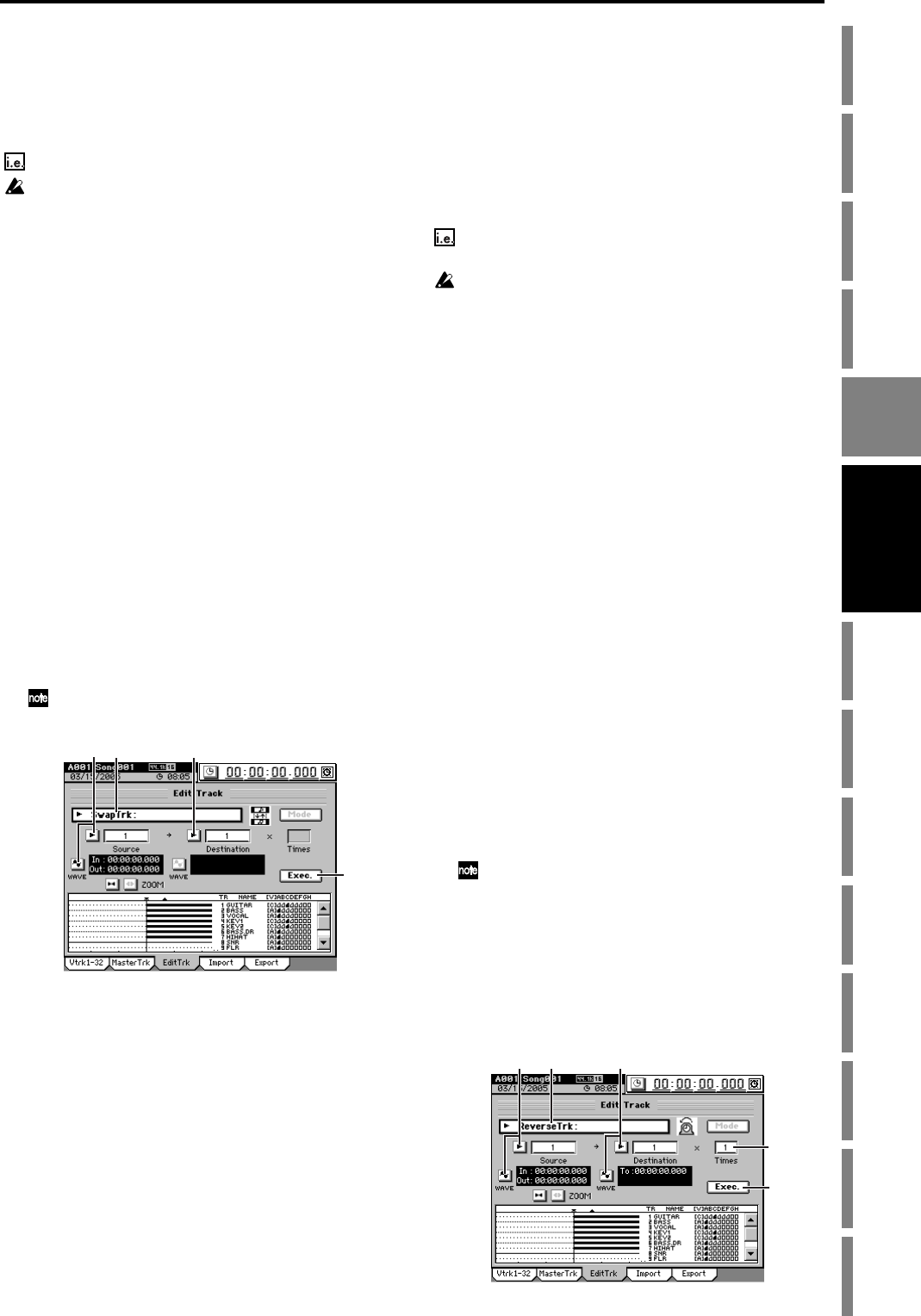
73
Operation
Song,
Locate
MixerEffects
Session
Drums™
Recorder
CDDataDriveUSBMIDIUpgrading
the system
Recovery
CD
ClickPoint
calibration
Exchange tracks (SwapTrk)
This command exchanges (swaps) recorded track data be-
tween the specified region (IN–OUT) and the corresponding
region of another track.
•You can swap the data of one or more tracks simultane-
ously.
Swapping the IN–OUT regions of track 1 and track 2.
Before you execute this operation, check the virtual track of the
Source and Destination tracks that you want to swap.
(1) Specify the region whose data will be swapped.
Set the following locations to specify the region for
swapping (→p.69).
• Set the IN point to specify the beginning of the region
to be swapped.
• Set the OUT point to specify the end of the region to
be swapped.
(2) Select “SwapTrk.”
In the TRACK, “EditTrk” tab page, click the Edit Trk
Type cell. In the Edit Trk Type dialog box, click “Swap-
Trk ” and click the OK button (or press the panel YES
key).
(3) Select the track numbers whose data you want to swap.
• Click the popup button of the Source cell, and choose
track “1” in the Source Track dialog box. You can also
click the cell to select this.
• Check the IN and OUT locations. If you want to set
the locations with more precision, click the Destina-
tion WAVE button, and use the Wave dialog box
(→p.128) to set the location.
(4) Select the swap-destination track number.
Click the popup button of the Destination cell, and
choose track “2” in the Destination Track dialog box.
You can also click the cell to select this.
If you specified two or more tracks as the “Source,” you must
specify the same number of tracks as the “Destination.”
(5) Execute the editing operation.
Click the Exec. button. Then in the SwapTrk dialog box,
click the Yes button (or press the panel YES key) to exe-
cute the operation.
When the operation is finished, the display will indicate
“Completed.” Click the OK button (or press the panel
YES key).
(6) Check the results of the editing operation.
Press the LOC 1/IN key, and play back from the IN loca-
tion to verify that the editing operation has done cor-
rectly.
If you are not satisfied with the results, you can use
Undo to return to the previous state. (→p.141)
Reverse a track (ReverseTrk)
This command copies the audio data in the specified region
(IN–OUT) of the track to the TO location “in reverse” (i.e., so
that the data will play backward).
• The data of the IN–OUT region can be copied one or more
times in succession by a single operation.
•You can copy just one track, or multiple tracks of data at
the same time.
• The existing track data at the copy-destination (TO loca-
tion) will be overwritten.
Copying the IN–OUT region of track 1 three times in re-
verse to the TO location of track 2
Select the virtual tracks of the copy-source (Source) and copy-des-
tination (Destination) before you make settings for this Copy op-
eration.
(1) Specify the region that you want to copy.
Set the following locations to specify the region for copy-
ing (→p.69).
• Set the IN point to specify the beginning of the region
to be copied
• Set the OUT point to specify the end of the region to
be copied
• Set the TO point to specify the beginning of the copy-
destination
(2) Select “ReverseTrk.”
In the TRACK, “EditTrk” tab page, click the Edit Trk
Type cell. In the Edit Trk Type dialog box, click
“ReverseTrk” and click the OK button (or press the
panel YES key).
(3) Select the track number whose data you want to use as
the reverse-source.
• Click the popup button of the Source cell, and choose
track “1” in the Source Track dialog box. You can also
click the cell to select this.
• Check the IN and OUT locations. If you want to set
the locations with more precision, click the Source
WAVE button, and use the Wave dialog box (→p.128)
to set the location.
(4) Select the reverse-destination track number.
• Click the popup button of the Destination cell, and
choose track “2” in the Destination Track dialog box.
You can also click the cell to select this.
If you specified two or more tracks as the “Source,” you must
specify the same number of tracks in “Destination.”
•Verify that the TO location is correct. If you want to set
the location with more precision, click the Destination
WAVE button, and make your settings in the Wave
dialog box (→p.128).
(5) Specify the number of time that you want to copy the
data.
In the Times cell, specify the number of copies as “3”.
(2) (4)(3)
(5)
(2)(3) (4)
(5)
(6)
Recorder


















